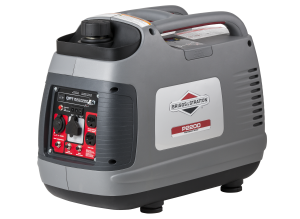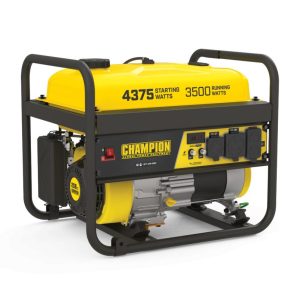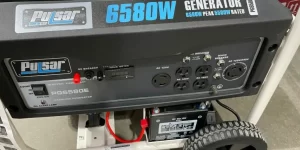Your Honda Generator Seizes Under Load (Resolved!)
Your generator appears to be struggling to keep running. When a load is applied to it, it continues to bog down.
When the carburetor is dirty, the fuel filter is clogged, the air filter is clogged, the choke is in the wrong position, the choke is stuck, or the spark arrestor screen is plugged, a Honda generator bogs down underload.
When working with a hot generator, exercise extreme caution. Remove the spark plug wire and allow the engine to cool before proceeding with repairs. Follow all of the safety precautions outlined in the Honda owner’s manual.
Table of Contents
6 Reasons a Honda Generator Bogs Down Under Load
Too Much Load is Applied for the Honda Generator Size
When your Honda generator stalls, the first thing to look for is the wattage requirements of the items powered by the generator. Compare this to the generator’s load limit to ensure you are not overloading the generator.
The required wattage must be less than the load limit. When the generator is overloaded, it begins to run slowly, bogs down, and may even shut down. It could also harm the generator and the items connected to it.
Follow these tips to determine the wattage capacity:
- Most electrical items have their wattage listed on a tag attached to the item.
- To start an item, some motors require more wattage. In this case, when calculating wattage requirements, the starting wattage should be used.
- To get a total, add the wattage of all items that will be plugged into the generator at the same time.
- This total wattage must be less than the wattage capacity of the generator.
Do not use more power than the generator can handle. Once the Honda generator is turned on, plug in one item at a time to avoid overloading the generator at startup.
Dirty Carburetor on a Honda Generator
Old gas in a Honda generator will leave a varnish coating the carburetor, causing fuel restrictions.
These restrictions can be caused by clogging of the fuel jet or by internal carburetor parts sticking, causing the carburetor to malfunction.
When this happens, not enough gas gets to the carburetor, causing your generator to run rough. To correct this, remove the carburetor and clean or replace it.
To clean the carburetor, take photos of the disassembly process to ensure that the small parts are placed in the correct positions when reinstalling the carburetor.
Take the carburetor out of the generator. Using a carburetor cleaner, remove as much buildup as possible. If any parts are damaged, use a carburetor rebuild kit to replace them. Install the carburetor after it has been cleaned and repaired.
If you don’t want to deal with small parts, you can buy and replace a complete carburetor instead of tearing it apart to clean and rebuild it.
Clogged Fuel Filter on a Honda Generator
The purpose of a fuel filter is to keep dirt out of the fuel system and to protect the engine from wear. When the filter isn’t changed on a regular basis, it can become clogged and prevent enough fuel from passing through.
A Honda generator will bog down if there is insufficient fuel flowing through the filter. If the filter becomes dirty, replace it with a new one.
To reduce the likelihood of a clogged filter on your generator, replace the fuel filter once a year, as most homeowners do. If you use it more frequently, you will need to replace the filter more frequently.
Plugged Air Filter on a Honda Generator
Similarly to how the fuel filter prevents dirt from entering the fuel system, the air filter prevents dirt from entering the air intake, ensuring that the engine receives clean air.
Running a clean air filter is critical for engine protection. When the air filter becomes clogged, it not only restricts the air required for the engine to run efficiently, but it can also cause the engine to bog down, overheat, and shut down.
Check the air filter to ensure it is clean and free of dirt and debris. If the air filter is damaged or extremely dirty, it must be replaced. If it’s in good shape but a little dirty, clean it according to the instructions below.
I recommend changing the air filter once a year. Before using the generator, you should also inspect and clean it.
Clean a Honda generator primary foam-style air filter
If you have a different type of filter, consult your operator’s manual for cleaning instructions.
- Take the air filter out of the housing.
- Remove any remaining dirt from the air filter housing and cover. Allow no dirt to enter the air intake.
- Examine the foam filter for damage and replace it if necessary.
- If the filter is in good condition, rinse it with soapy water until the water runs clear.
- Allow the filter to dry after squeezing it.
- Clean engine oil should be used to coat the filter (this is to help trap dirt). Remove any excess oil from the filter.
- Replace the air filter.
- Reassemble the air filter cover.
Stuck Choke on a Honda Generator
A Honda generator can bog down if the choke is not in the proper position, either due to incorrectly adjusting the choke lever or because the choke is stuck.
To start a cold engine, the choke restricts airflow. It must be in the open/closed position. This allows more fuel to reach the engine, allowing it to form a combustion and run.
Once the engine has warmed up, the choke lever must be adjusted to the off/open position to allow air to enter the engine and keep it running. If the engine does not get enough air, it will bog down and may not start.
If the choke is correctly positioned but you still have airflow issues, check the choke linkage and choke plate to ensure they are not stuck and are opening and closing the choke correctly.
To make a stuck choke plate move freely, use carburetor cleaner.
Clogged Spark Arrestor on a Honda Generator
On the muffler, there is a spark arrestor screen. This is a necessary component to prevent sparks and hot exhaust material from escaping from the muffler. This will help to reduce burn injuries and fires.
When this metal screen becomes clogged with soot, the generator begins to run rough and may shut down because the hot exhaust air cannot exit the engine.
Remove the spark plug and allow the muffler to cool before removing and cleaning the spark arrestor. Examine the condition of the spark arrestor screen. If you find any tears or holes in the mesh screen, replace it with a new one.
If the screen appears to be in good condition, use a commercial solvent to clean it or lightly brush it with a small metal brush to remove soot deposits. Replace the screen on the muffler once it has been cleaned.







